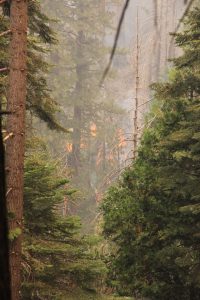Benefits of Forest Fires
If we can pull away from our own, albeit very real, negative experiences from the Ferguson and Donnell fires and survey the bigger picture concerning forest fires, and the benefits caused by them, we may gain a better understanding and appreciation of the Sierra Nevada Mountains, and the Stanislaus Forest where we have chosen to live.
According to a study published in the International Journal of Forestry Research, “Changes in environmental conditions following a fire can reduce biotic stress pressure experienced by plants.” The article suggests that there is a strong relationship between the absence of infection and time since the last burn. Drier microclimates after a fire can limit fungal infection and growth on leaves and needles. Conifer trees have actually evolved and become stronger in response to millions of years of fires.
After settlement by Europeans, especially during the 20th century (aided by Smokey the Bear cautioning everyone to prevent forest fires), the lack of fires allowed the forest to grow dangerously dense and the forest floor to fill up with dried vegetation. Plants native to this area and essential to feed the animals died off due to lack of sunlight caused by the dense forest growth. What were naturally-occurring, relatively small fires, turned into raging infernos engulfing huge areas and killing everything within their paths.
Forest fires allow conifers to remain the dominant tree species in the Sierra. The heat from the fires, open serotinous cones and allows their seeds to fall to the forest floor. These then germinate and grow into new trees. Some examples of plants that depend on fire for germination are from the buckthorn family, morning glory, rock rose family and ceanothus. Chaparral plants, including manzanita and scrub oak, also require intense heat for seed germination.
Fires are also essential in removing exotic plants from the ecosystem, giving an edge to native species so they can germinate and grow. The forest fauna depend on these native plants for food. Dead wood, withering plants and weaker trees are removed by fire, allowing sunlight to stream through the fire-opened areas. The newly admitted light gives rise to an abundance of wildflowers and stronger, more robust forest growth. Reducing the competition for nutrients and water allows the established trees to grow stronger. Less competition for water results in fuller rivers and streams.
Fire is also a scourge to invasive insects and bugs – like the aggressive bark beetle – that prey on trees. These beetles infest drought-stressed or weakened trees. Their growth over the last decade has burgeoned causing trees to die off and become fuel for major fires. More trees die each year from insects than from fire. These insects also act as vectors, or carriers, of diseases fatal to many of the forest trees.
Lack of funding from Congress for national forests, and lack of awareness of good forest stewardship, has contributed to the intensity of the fires in the last fifty years. It is much cheaper to pay for forest clean up than it is to fight a major forest fire. California wildfires cost billions in state and federal suppression efforts. It is up to us to raise everyone’s awareness about what it takes to keep our forests healthy so we can all thrive in the Sierra Nevada Mountains and foothills.
Francie McGowan is a University of California Cooperative Extension Master Gardener of Tuolumne County.
Sources consulted for this article:
“Smoke Infusion for Seed Germination in Fire-adapted Species,” Daniela Shebitz, Anne Andreu, Marlo Mytty, Doug Schmitt, and Mike Cooksey
U.C. Integrated Pest Management: http://www.ipm.ucdavis.edu/PMG/PESTNOTES/pn7421.html
Sierra Forest Legacy, www.sierraforestlegacy.org/ “Physiological Effects of Smoke Exposure on Deciduous and Conifer Tree Species,” by W. John Calder, Greg Lifferth from the Department of Plant and Wildlife Sciences, Brigham Young University, Provo, Utah; Max A. Moritz and Samuel B. St. Clair from the Department of Environmental Science, Policy, and Management, University of California, Berkeley.
UCCE Master Gardeners of Tuolumne County can answer home gardening questions. Call 209-533-5912 or go to: http://ucanr.edu/survey/survey.cfm?surveynumber=7269 to fill out our easy-to-use problem questionnaire. Check out our website at: http://cecentralsierra.ucanr.edu/Master_Gardeners/ You can also find us on Facebook, or pick up the local Master Gardener book “Sharing the Knowledge: Gardening in the Mother Lode” at Mountain Books or the UCCE Office both in Sonora, CA.

